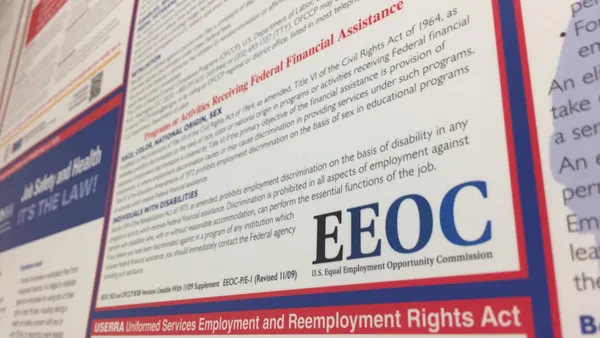Dive Brief:
- Private California employers that are required to file an EEO-1 report with the U.S. Equal Employment Opportunity Commission must also submit a pay data report to the state's Department of Fair Employment and Housing on or before March 31, 2021, according to a law signed Sept. 30 by Gov. Gavin Newsome.
- Each employer filing a report must include the number of employees from the previous calendar year during a single pay period, or "snapshot," of the employer's choice, categorized by race, ethnicity and sex across each of the law's specified job categories. Employers also must include the annual earnings — as shown on Form W-2 — and total number of hours worked of each employee in the snapshot, regardless of whether the employee worked for the full calendar year.
- Additionally, each employer must include the number of employees whose annual earnings fell within each of the pay bands used by the U.S. Bureau of Labor Statistics in its Occupational Employment Survey, sorted by race, gender and ethnicity. The snapshot used in the analysis must cover a single pay period between Oct. 1 and Dec. 31 of the reporting year.
Dive Insight:
Employers that are required to produce a pay data report under the law, Senate Bill No. 973, "should begin to evaluate their readiness for compliance as soon as possible," attorneys with Seyfarth Shaw said in an analysis. The analysis noted that SB 973 does not clarify whether the reporting requirements apply to employers with more than 100 employees in California or more than 100 employees overall.
"Employers would also be well-advised to conduct a proactive pay equity analysis now, to address any areas of concern," the attorneys said. "While the data to be reported and analyzed by the DFEH will not likely be very meaningful given the significant issues outlined above, the new pay report will likely put more emphasis on pay equity and employers should be prepared for this heightened scrutiny."
California's law follows the EEOC's decision not to renew its own pay data collection program, EEO-1 Component 2, following the completion of pay data collection for the 2017 and 2018 calendar years. The Trump administration attempted to stay that data collection in 2017 before a federal judge invalidated the administration's stay two years later. The agency's processing of Component 2 is ongoing, with the most recent update in July indicating that EEOC will finish its work by Dec. 31, 2021.
The agency announced last year that it would publish an advanced notice of proposed rulemaking on pay data collection in 2020, but it has not yet done so. At a public hearing last year, employer advocates criticized several aspects of the Component 2 data collection, noting the burden involved in assembling data for collection as well as concerns about potential inaccuracies regarding the use of pay band data specifically. Those in favor of the collection, however, cited the lack of alternative proposals and the need for progress on pay equity as researchers continue to find evidence of gaps.
During a 2019 conference, EEOC Commissioner Charlotte A. Burrows said pay discrimination "is hard to fix because it's hard to find," adding that the agency discovers many instances of such discrimination "by accident." While not all pay discrepancies amount to discrimination, according to Burrows, such gaps can lead to financial losses for workers over the course of their careers.
Regardless of the state of mandatory pay-data collections, employees in many industries have driven the conversation by self-disclosing pay. Such disclosures may constitute protected concerted activity, leading employment law attorneys to recommend employers refrain from retaliatory responses.
In addition to conducting pay audits internally, employers may be able to address pay gaps by ensuring that job descriptions are accurate, participating in survey groups to see how competitors and other companies pay employees and eliminating information such as salary history from interview processes, attorneys previously told HR Dive.











